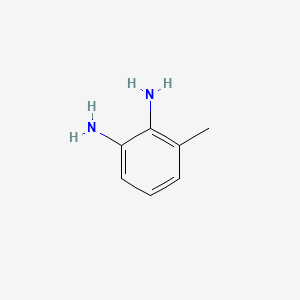D0705 | 3-methylbenzene-1,2-diamine
| Toxicity | Dose | Time | Species | Model | Method | Action | Positive criterion | Reference |
|---|---|---|---|---|---|---|---|---|
| MEMBRANE POTENTIAL | 21.74±3.65 | human | qHTS-HepG2 | MMP assay | decrease | IC50 | 163 | |
| MEMBRANE POTENTIAL | 28.18 | human | HepG2 | MMP assay | decrease | IC50 | 163 | |
| MEMBRANE POTENTIAL | 36.64±11.80 | rat | hepatocytes | MMP assay | decrease | IC50 | 163 | |
| Pictogram | Signal | Statements | Precautionary Statement Codes |
|---|---|---|---|
    |
Danger |
Aggregated GHS information provided by 237 companies from 7 notifications to the ECHA C&L Inventory. Each notification may be associated with multiple companies. H301 (83.97%): Toxic if swallowed [Danger Acute toxicity, oral] H302 (16.03%): Harmful if swallowed [Warning Acute toxicity, oral] H312 (100%): Harmful in contact with skin [Warning Acute toxicity, dermal] H315 (18.14%): Causes skin irritation [Warning Skin corrosion/irritation] H317 (81.86%): May cause an allergic skin reaction [Warning Sensitization, Skin] H319 (100%): Causes serious eye irritation [Warning Serious eye damage/eye irritation] H332 (83.54%): Harmful if inhaled [Warning Acute toxicity, inhalation] H335 (17.72%): May cause respiratory irritation [Warning Specific target organ toxicity, single exposure Respiratory tract irritation] H341 (49.37%): Suspected of causing genetic defects [Warning Germ cell mutagenicity] H350 (81.86%): May cause cancer [Danger Carcinogenicity] H361 (49.37%): Suspected of damaging fertility or the unborn child [Warning Reproductive toxicity] H373 (49.37%): Causes damage to organs through prolonged or repeated exposure [Warning Specific target organ toxicity, repeated exposure] H411 (81.86%): Toxic to aquatic life with long lasting effects [Hazardous to the aquatic environment, long-term hazard] Information may vary between notifications depending on impurities, additives, and other factors. The percentage value in parenthesis indicates the notified classification ratio from companies that provide hazard codes. Only hazard codes with percentage values above 10% are shown. |
P201, P202, P260, P261, P264, P270, P271, P272, P273, P280, P281, P301+P310, P301+P312, P302+P352, P304+P312, P304+P340, P305+P351+P338, P308+P313, P312, P314, P321, P322, P330, P332+P313, P333+P313, P337+P313, P362, P363, P391, P403+P233, P405, and P501; (The corresponding statement to each P-code can be found at the GHS Classification page.) |
  |
Warning |
H302: Harmful if swallowed [Warning Acute toxicity, oral] H317: May cause an allergic skin reaction [Warning Sensitization, Skin] H341: Suspected of causing genetic defects [Warning Germ cell mutagenicity] |
P201, P202, P261, P264, P270, P272, P280, P281, P301+P312, P302+P352, P308+P313, P321, P330, P333+P313, P363, P405, and P501; (The corresponding statement to each P-code can be found at the GHS Classification page.) |
| 1,2-Benzenediamine, 3-methyl- | 1,2-Diamino-3-methylbenzene | 1-Methyl-2,3-phenylenediamine |
| 105898-71-3 | 2,3 Diaminotoluene | 2,3 diamino toluene |
| 2,3-DIAMINOTOLUENE | 2,3-Diaminotoluene, 97% | 2,3-TOLUENEDIAMINE |
| 2,3-Toluylenediamine | 2,3-Tolylenediamine | 2,3-diamino toluene |
| 2,3-diamino-toluene | 2-Amino-3-methylphenylamine | 2687-25-4 |
| 2687-25-4 2,3-diaminotoluene | 2C9; | 3-13-00-00277 (Beilstein Handbook Reference) |
| 3-Methyl-1,2-benzenediamine | 3-Methyl-1,2-benzenediamine # | 3-Methyl-1,2-phenylenediamine |
| 3-Methyl-benzene-1,2-diamine | 3-Methyl-o-phenylenediamine | 3-methyl-1,2-diaminobenzene |
| 3-methyl-l,2-benzenediamine | 3-methyl-ortho-phenylenediamine | 3-methylbenzene-1,2-diamine |
| 4CH-013408 | 4mre | 687D254 |
| A19636 | A801332 | AB1005614 |
| AC-9820 | ACMC-209gth | ACT13373 |
| AK-61303 | AKOS000121501 | AM61874 |
| ANW-26067 | AS00446 | AXNUJYHFQHQZBE-UHFFFAOYSA-N |
| BDBM50008913 | BIDD:GT0074 | BRN 0907184 |
| CAS-2687-25-4 | CCRIS 7692 | CHEMBL3183504 |
| CM13949 | CS-W016576 | CTK3J2356 |
| D3788 | DB-047035 | DSSTox_CID_7494 |
| DSSTox_GSID_27494 | DSSTox_RID_78471 | DTXSID4027494 |
| EINECS 220-248-5 | FT-0609511 | HSDB 6077 |
| InChI=1/C7H10N2/c1-5-3-2-4-6(8)7(5)9/h2-4H,8-9H2,1H | KS-00000KHM | KSC492G5N |
| LS-154039 | MCULE-6874836416 | MFCD00011589 |
| NCGC00247901-01 | NCGC00247901-02 | NCGC00254106-01 |
| NCGC00258011-01 | PS-5505 | PubChem4538 |
| Q-9260 | Q27289352 | RTC-060744 |
| SBB051691 | SC-03025 | SCHEMBL42498 |
| SR8WC7LLQ2 | ST2417802 | ST51038114 |
| TC-060744 | TRA0026413 | Toluene, 2,3-diamino- |
| Toluene-2,3-diamine | Tolylene-2,3-diamine | Tox21_200457 |
| Tox21_300092 | UNII-NJX12DY6BY component AXNUJYHFQHQZBE-UHFFFAOYSA-N | UNII-SR8WC7LLQ2 |
| V0776 | W-107145 | WT131 |
| Z1359882005 | ZINC153100 | toluene diamine |
| CAS Number | 105898-71-3, 1246820-38-1, 25376-45-8, 2687-25-4, 59007-80-6 |
| PubChem Compound | 17593 |

